It looks like you're using an Ad Blocker.
Please white-list or disable AboveTopSecret.com in your ad-blocking tool.
Thank you.
Some features of ATS will be disabled while you continue to use an ad-blocker.
share:
Back in the 80's i had the pleasure of attending my first monster truck show..
At the time, Bigfoot was the main attraction..
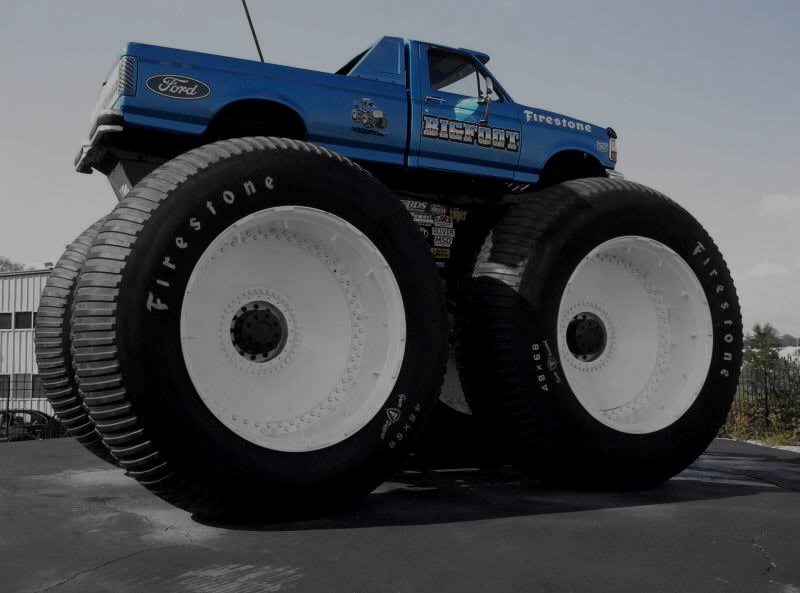
Upon seeing this Monster Truck for the first time, I was awestruck at its massive tires!
After the show i went and talked to one of the crew chiefs who worked on Bigfoot.
My first question was "where in the world did you get those massive tires"?
I can't recall the guys name anymore but he told me they were from a Sno-Train..or overland Train.
So i just had to see what i could find out about these Sno Trains..
So..let's have a look, shall we?
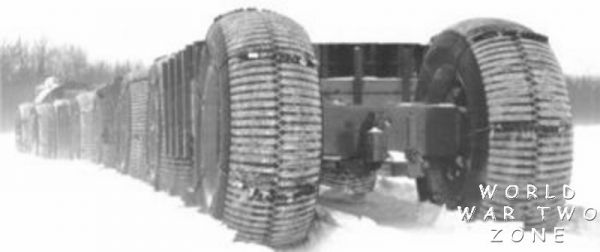
Is that cool or what? That's the back side or tail of the train..

How cool are these massive Sno Trains..eh?
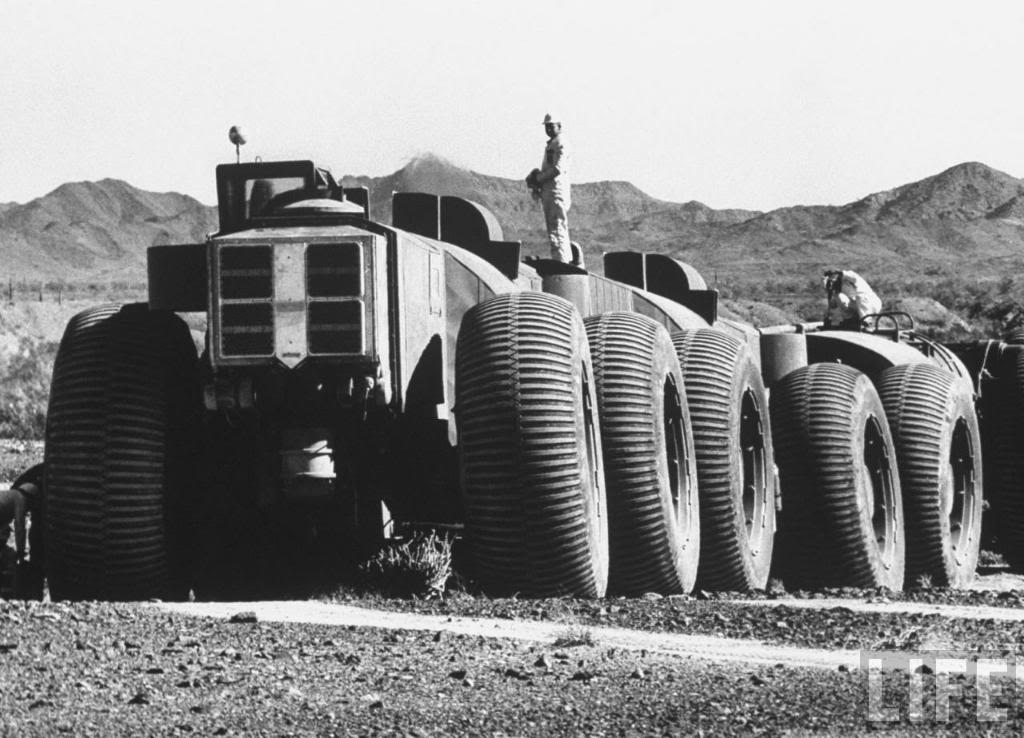
Here is one of the same kind of tire that was used on the original Bigfoot..
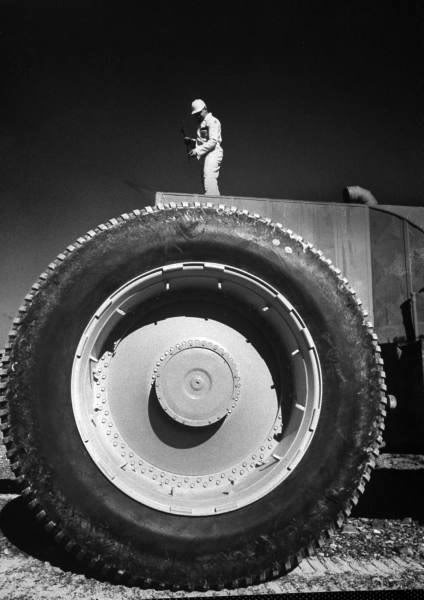
Also, to give you all an idea how long these Massive trains were..Behold!
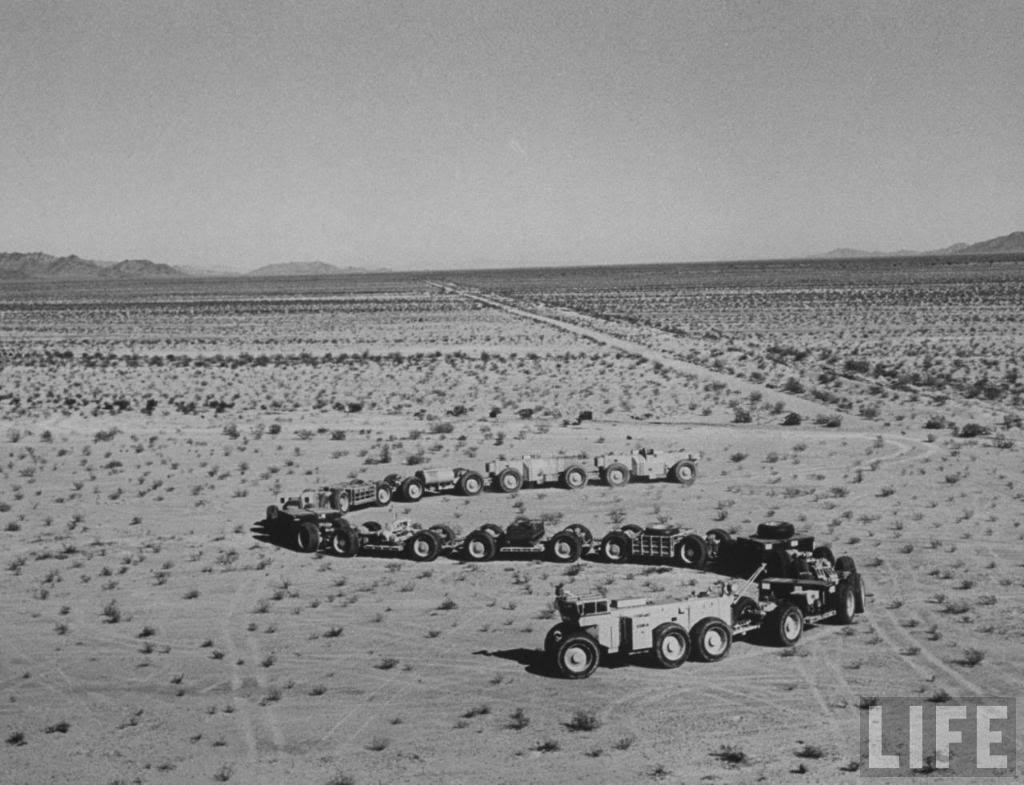
I hope you all have enjoyed today's History lesson on Sno-Trains..
They have always been a favorite of mine..
bigfoot source
sno train source

At the time, Bigfoot was the main attraction..

Upon seeing this Monster Truck for the first time, I was awestruck at its massive tires!
After the show i went and talked to one of the crew chiefs who worked on Bigfoot.
My first question was "where in the world did you get those massive tires"?
I can't recall the guys name anymore but he told me they were from a Sno-Train..or overland Train.
so Chandler outfitted his "Bigfoot 4" vehicle with 10-foot-tall tires he had purchased from a junkyard owner in Seattle, Washington for only $1000. The tires had been previously used by the U.S. Army in Alaska on their overland train in the 1950s
So i just had to see what i could find out about these Sno Trains..
So..let's have a look, shall we?

Is that cool or what? That's the back side or tail of the train..
In the 1950s, the U.S. Army experimented with a 13-car, 600-foot-long wheeled train that could haul more than a hundred tons of supplies over sand or snow. The kicker: it was a hybrid-electric with many of the same features of the latest military prototypes. The TC-497 “Overland Train,” designed by earthmoving pioneer R.G. Letourneau, was briefly used to supply Alaskan radar stations and construct remote oil pipelines. “The first models were so successful that a Mark II version was developed,” says WIB-pal Steve Weintz. ”This was an amazing machine: gas-turbine-electric hybrid drive, 150-ton payload, a crew of six provided with bridge, bunkhouse, and galley and a self-tracking steering system. Additional power cars and cargo cars could be added as needed.”

How cool are these massive Sno Trains..eh?

Here is one of the same kind of tire that was used on the original Bigfoot..

Also, to give you all an idea how long these Massive trains were..Behold!

I hope you all have enjoyed today's History lesson on Sno-Trains..
They have always been a favorite of mine..
bigfoot source
sno train source

edit on 28-1-2012 by baddmove because: added video
edit on 28-1-2012 by baddmove because: (no reason
given)
Aww that last picture made me sad.
I vaguely remember these things and I think they are so awesome! I really enjoy reading about ideas and technology that had much potential but got passed by in the river of history. If we had discovered vulcanization for rubber much earlier I wonder if people could have adapted this kind of idea to the steam engine?
I vaguely remember these things and I think they are so awesome! I really enjoy reading about ideas and technology that had much potential but got passed by in the river of history. If we had discovered vulcanization for rubber much earlier I wonder if people could have adapted this kind of idea to the steam engine?
reply to post by Mkoll
Thanks for the reply..
It is really hard to find anything on Sno-trains anymore..
They were short lived but still awesome imho..
Thanks for the reply..
It is really hard to find anything on Sno-trains anymore..
They were short lived but still awesome imho..
Whoa!!! I want one of those. Imagine one of those on our English roads. No parking space? Just roll over a few cars and park up.
Looks like this one will have a home in a museum..
This is a LCC-1 LeTourneau Trackless Land Train, recently purchased and brought down from Fairbanks, Alaska to Whitehorse, Yukon for display at the Yukon Transportation Museum
edit on 28-1-2012 by baddmove because: (no reason given)
I also found this very short video..
it was too late to edit my OP...
it was too late to edit my OP...
reply to post by baddmove
These are absolutely amazing. and they would have been the life support for some out of the way towns.
By looking at this site Top 13 polar Super Vehicles they still use snow trains, only there tyres are not as big, and most are tracked now.
Very "COOL" thread baddmove
love and harmony
Whateva
These are absolutely amazing. and they would have been the life support for some out of the way towns.
By looking at this site Top 13 polar Super Vehicles they still use snow trains, only there tyres are not as big, and most are tracked now.
Very "COOL" thread baddmove
love and harmony
Whateva
reply to post by Whateva69
Thanks my Friend..
yes, i believe they were the life blood of many outposts and people working on the pipeline back in the day..
these massive beast's would deliver all the goods for miles around..
150 tons at a time..
imagine that...
Thanks my Friend..
yes, i believe they were the life blood of many outposts and people working on the pipeline back in the day..
these massive beast's would deliver all the goods for miles around..
150 tons at a time..
imagine that...
The original "Ms. Big Foot" (the one with the really tall tires in the OP) is enshrined outside a business not far from where I live. I pass it
every time I go to visit my grandmother
reply to post by baddmove
We are pretty lucky to have the resources of the ATS minds putting this kind of amazing stuff back into our minds.Really Had forgotten they ever existed...cool stuff
Thnx
Nice break from the typical doom and Gloom
We are pretty lucky to have the resources of the ATS minds putting this kind of amazing stuff back into our minds.Really Had forgotten they ever existed...cool stuff
Thnx
Nice break from the typical doom and Gloom
edit on 28-1-2012 by wutz4tom because: (no reason given)
reply to post by wutz4tom
Thanks..
like i said in another reply..
hard to find pics on these anymore...
Thanks..
like i said in another reply..
hard to find pics on these anymore...
It amazes me that people here on ATS do not find this thread worthy of their time..
I spent a lot of time looking for these images..
and yet you all seem to be interested in doom and gloom..
this is a part of our history and should be revered as such..
I am disappointed in my fellow ATS'rs..
I'm not looking for flags or stars...
I just want feedback and comments on this thread..
this isn't a youtube video with a one liner..
this means something to me..
I spent a lot of time looking for these images..
and yet you all seem to be interested in doom and gloom..
this is a part of our history and should be revered as such..
I am disappointed in my fellow ATS'rs..
I'm not looking for flags or stars...
I just want feedback and comments on this thread..
this isn't a youtube video with a one liner..
this means something to me..
Thanks for the post op! Ive always been interested in military history and had no idea these things existed. Where was that last pic taken do you
knôw? Somewhere in Alaska I assume?
Found your thread thru your sig on another thread. I never even saw the original post. Now I'm sorry that I missed it but glad that I finally found
it. This thing is wicked cool. I never heard of these trains before. What a cool concept. I'm kind of surprised that they don't use these or
something like them any more. What a useful and practical vehicle. Thanks for posting this. Now I've learned my new thing for today. The rest of
things I learn today are all gravy.S&F for great find.
reply to post by baddmove
WOW! What a cool concept! I had never heard of this one before.... thanks baddmove for putting this together and thanks to lonegurkha for PMing me to tell me to check this out.
You are right though, baddmove, there is next to nothing on the net about these fantastic machines. I just did a google search and it only comes back with a few legit hits. But I managed to pick up a Wiki page on it (yeah I know not the most reliable of sources) that has some really cool history on these machines. Here is something that I found particularly interesting:
Wiki Source
So here we see even more history on this amazing machine, at least the concept from which the sno-train was developed.
And here is a word on what happened to them in the 60's:
I'm thinking one of the last pictures you posted is of this control cab of the Mark II since it is mentioned that it's on its way to Yuma?
Here is some reading from Popular Mechanics articles from the early 60s on the man and machine:
1960 Popular Mechanics Article
1962 Popular Mechanics Article
Again, thanks baddmove for an interesting look back at something that until you posted this I had no idea even existed. I've enjoyed looking into this further and hope the info I found can shed some more light on this for you, it certainly did for me.
WOW! What a cool concept! I had never heard of this one before.... thanks baddmove for putting this together and thanks to lonegurkha for PMing me to tell me to check this out.
You are right though, baddmove, there is next to nothing on the net about these fantastic machines. I just did a google search and it only comes back with a few legit hits. But I managed to pick up a Wiki page on it (yeah I know not the most reliable of sources) that has some really cool history on these machines. Here is something that I found particularly interesting:
During this period the U.S. and Canada were in the process of developing the DEW Line, which was located in areas with no roads, few airbases, and in areas where the sea ice often prevented ships from accessing the sites. On 15 April 1954 the company demonstrated VC-12 to the US Army Transportation Research and Development Command, or TRADCOM, proposing that the system would be useful for logistics operations in the arctic if equipped with more wheels.
TRADCOM offered funding to create the TC-264 Sno-Buggy, which had eight huge 120-inch (3.0 m) rubber tires, arranged in pairs and driven by four motors powered by a single Allison V-1710 engine running on butane. The resulting vehicle has an enormous amount of tire area to vehicle weight, allowing it to float on the tundra and snow. First unveiled in June 1954, the Sno-Buggy was sent to Greenland for testing
Wiki Source
So here we see even more history on this amazing machine, at least the concept from which the sno-train was developed.
And here is a word on what happened to them in the 60's:
Final specifications were completed in 1960, and construction took most of 1961. After preliminary testing, it was handed to the Army in February 1962, and shipped to the Yuma Proving Ground in Yuma, Arizona. In testing under the "Project OTTER", for "Overland Train Terrain Evaluation Research", the vehicle performed well. But in the end the Army gave up on the idea as newer heavy-lift helicopters like the S-64 Skycrane made the train concept outdated.[8]
The vehicle remained unused for a time, and was then put up for sale for $1.4 million in 1969.[9] All that remains of the Mark II is the control cab which remains at Yuma, the rest was sold off to a local scrap dealer. The Mark II retains the record for the longest offroad vehicle in the world
I'm thinking one of the last pictures you posted is of this control cab of the Mark II since it is mentioned that it's on its way to Yuma?
Here is some reading from Popular Mechanics articles from the early 60s on the man and machine:
1960 Popular Mechanics Article
1962 Popular Mechanics Article
Again, thanks baddmove for an interesting look back at something that until you posted this I had no idea even existed. I've enjoyed looking into this further and hope the info I found can shed some more light on this for you, it certainly did for me.
reply to post by MyMindIsMyOwn
Thanks for the awesome reply!
Those Popular Mechanics links never even showed up for me..
Thank you for posting them,
Thanks for the awesome reply!
Those Popular Mechanics links never even showed up for me..
Thank you for posting them,
If the Germans had these things during WWII I wonder if it would have made Barbarossa winnable?
reply to post by Mkoll
yea...who knows..
i looked for a German version..
all i could find was Russian..
pretty cool looking too..
yea...who knows..
i looked for a German version..
all i could find was Russian..
pretty cool looking too..
reply to post by baddmove
Thank you OP great read , it really makes me wonder with the current levels of technology the US could keep any bases they have established in the Arctic regions supplied and hidden from prying eyes. I have always wandered what the true reason for Operation High Jump was , for are Military to send so much hardware to the South pole with PaperClip in full swing and the amount of gossip over the Nazis subs finding something and establishing a base ..I have always felt that every BS story to come out was all CIA and NSA noise , counter Intel keep people chasing BS so long they no longer no the difference between fact and fiction .I feel myself that Antarctica hides an ancient race of people who were destroyed by the last pole flip and even wit there level of tech the knew they could not survive the reforming of the surface plates of the Earth ...SO take all that and the snow trains and i SEE huge missions to aquire whatever is buried down there , while they throw us BS like Lake Vostock ..Throw us crumbs keep us away from the truth
Thank you OP great read , it really makes me wonder with the current levels of technology the US could keep any bases they have established in the Arctic regions supplied and hidden from prying eyes. I have always wandered what the true reason for Operation High Jump was , for are Military to send so much hardware to the South pole with PaperClip in full swing and the amount of gossip over the Nazis subs finding something and establishing a base ..I have always felt that every BS story to come out was all CIA and NSA noise , counter Intel keep people chasing BS so long they no longer no the difference between fact and fiction .I feel myself that Antarctica hides an ancient race of people who were destroyed by the last pole flip and even wit there level of tech the knew they could not survive the reforming of the surface plates of the Earth ...SO take all that and the snow trains and i SEE huge missions to aquire whatever is buried down there , while they throw us BS like Lake Vostock ..Throw us crumbs keep us away from the truth
new topics
-
Holy Cow! Erm...Six Legged Turkey!!
World Sports: 35 minutes ago -
Ben Habib has Left Reform UK
Regional Politics: 3 hours ago -
Turkey Day Rhyme…
Short Stories: 3 hours ago -
Can someone please translate Biden's speech?
US Political Madness: 4 hours ago -
NIH Chief Confesses COVID Initiatives Were "Completely Made Up " OMG Investigates
Health & Wellness: 5 hours ago -
Awesome Dip Recipe
Food and Cooking: 8 hours ago -
Vladimir Putin's speech at the meeting of the CSTO Collective Security Council
World War Three: 8 hours ago
top topics
-
Happy Thanksgiving to ATS
General Chit Chat: 16 hours ago, 9 flags -
NIH Chief Confesses COVID Initiatives Were "Completely Made Up " OMG Investigates
Health & Wellness: 5 hours ago, 9 flags -
Can someone please translate Biden's speech?
US Political Madness: 4 hours ago, 7 flags -
Traveling the world with no passport
Social Issues and Civil Unrest: 13 hours ago, 6 flags -
Vladimir Putin's speech at the meeting of the CSTO Collective Security Council
World War Three: 8 hours ago, 6 flags -
Awesome Dip Recipe
Food and Cooking: 8 hours ago, 4 flags -
Turkey Day Rhyme…
Short Stories: 3 hours ago, 4 flags -
Ben Habib has Left Reform UK
Regional Politics: 3 hours ago, 4 flags -
Holy Cow! Erm...Six Legged Turkey!!
World Sports: 35 minutes ago, 1 flags
active topics
-
NIH Chief Confesses COVID Initiatives Were "Completely Made Up " OMG Investigates
Health & Wellness • 9 • : underpass61 -
Vladimir Putin's speech at the meeting of the CSTO Collective Security Council
World War Three • 52 • : Dalamax -
Traveling the world with no passport
Social Issues and Civil Unrest • 7 • : Flyingclaydisk -
Holy Cow! Erm...Six Legged Turkey!!
World Sports • 0 • : Flyingclaydisk -
V.P. Kamala Harris releases a video and nobody understands why
US Political Madness • 80 • : xuenchen -
Turkey Day Rhyme…
Short Stories • 3 • : Shoshanna -
Interesting Video-UFO?
Aliens and UFOs • 20 • : BrucellaOrchitis -
Happy Thanksgiving to ATS
General Chit Chat • 13 • : gort69 -
Why isn't Psychiatry involved?
Social Issues and Civil Unrest • 16 • : BrucellaOrchitis -
Simple Thanksgiving
Food and Cooking • 33 • : GENERAL EYES
